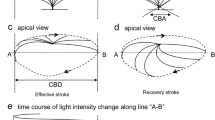Summary
Nasal allergy is a disease ensuing from type-I allergic reactions in the nasal cavity. A correct understanding of this process requires further investigation of the non-allergic pathology present. In the allergic state, the function of the nasal cilia is considered to be involved in the invasion of allergens into the nasal mucosa, and may also be involved with the manifestation and progression of the disease produced. In the present study, we examined the ciliary activity of the nasal mucosa of 35 patients with nasal allergies by using the photo-electric method of Ohashi and Nakai to better understand the non-allergic pathologies present. The nasal cilia of four healthy volunteers served as controls. In addition, a multivalent analysis was made according to quantifying theory I in order to define the effects of various factors on ciliary activity in the nasal mucosa during the allergic state.
The following results were found in our present study. Ciliary activity was observed in 32 of 35 patients with nasal allergy. The mean value of the ciliary activity in these patients was 498±195 beats/min, while that of the normal controls was 753±46 beats/min. The ciliary activity in the nasal mucosa in the allergic state declined as the morbid period was prolonged; this decline in ciliary activity was relatively great in cases of perennial allergies aggravated by season-specific allergens.
Similar content being viewed by others
References
Chevance LG (1971) Experimental pollinosis. Acta Otolaryngol (Stockh) 72:121–133
Hayashi C (1952) On the prediction of phenomena from quantitative data and quantification of the quantitative data from the mathematical-statistical point of view. Ann Inst Statist Math Tokyo 3:69–98
Imoto T, Nakai Y (1983) Otoneurological test results analyzed by means of a quantitative statistical method. ORL 45:203–215
Imoto T, Stahle J (1983) The clinical picture of Meniere's disease in the light of glycerin and urea tests. Acta Otolaryngol (Stockh) 95:247–256
Mygind N, Bretlau P (1973) Scanning electron microscopic studies on the human nasal mucosa in normal persons and in patients with perennial rhinitis. I. Cilia and microvilli. Acta Allergol 28:9–27
Ohashi Y (1983) The function and morphology of respiratory ciliated cells. J Osaka City Med Cent 32:427–460
Ohashi Y, Nakai Y (1983) Functional and morphological studies on chronic sinusitis mucous membrane. 1. Reduced ciliary action in chronic sinusitis. Acta Otolaryngol [Suppl] (Stockh) 397:3–9
Ohashi Y, Nakai Y (1983) Functional and morphological studies on chronic sinusitis mucous membrane. 2. Functional and morphological pathology of chronic sinusitis mucous membrane. Acta Otolaryngol [Suppl] (Stockh) 397:11–48
Ohashi Y, Nakai Y (1984) Mucociliary activities in fetal rabbits. Acta Otolaryngol (Stockh) 97:351–358
Ohashi Y, Nakai Y, Harada H, Muraoka M, Osako S (1982) Experimental study of the effect of pollen acid on the respiratory tract mucosa. Observation of motive function and microconstruction of cilium. J Jpn Bronchoesophagol Soc 33:287–296
Ohashi Y, Nakai Y, Zushi K, Muraoka M, Minowa Y, Harada H, Masutani H (1983) Functional and morphological studies on chronic sinusitis mucous membrane. 3. Enhancement of ciliary action by a β-adrenergic stimulant. Acta Otolaryngol [Suppl] (Stockh) 397: 49–59
Ohashi Y, Nakai Y, Nakata J, Ikeoka H, Maruoka K, Horiguchi S, Teramoto K (1983) Effects on the ciliary activity and morphology of rabbit's nasal epithelium exposed to tetrahydrofuran. Osaka City Med J 29:1–14
Ohashi Y, Nakai Y, Kihara S (1985) Ciliary activity at the middle ear lining of guinea pigs. Ann Otol Rhinol Laryngol (in press)
Okuda M (1974) Mechanism and pathogenesis of ragweed pollen nasal allergy. Wakayama Med Rep 15:143–152
Okuda M, Ishikawa T, Saito Y, Shimizu T, Baba S (1984) A clinical evaluation of N′-5 with perennial-type allergic rhinitis. A test by the multi-clinic, intergroup, doubleblind comparative method. Ann Allergy 53:178–185
Reimer Å (1978) The mucociliary activity of the upper respiratory tract. III. A function and morphological study on human and animal with special reference to maxillary sinus disease. Acta Otolaryngol [Suppl] (Stockh) 355:1–20
Sakakura Y (1974) Mucociliary function during experimentally induced rhinovirus infection in man. Ann Otol Rhinol Laryngol 82:203–211
Santa CR (1974) Tracheal mucous velocity in normal and patients with obstructive lung diseases; effect of terbutaline. Am Rev Respir Dis 109:458–463
Takasaka T, Sato M, Onodera A (1980) Atypical cilia of the human nasal mucosa. Ann Otol Rhinol Larynol 89:37–45
Wakabayashi N (1977) Mucociliary transport in chickens infected with Newcastle disease virus and exposed to sulfur dioxide. Arch Environ Health 32:101–108
Author information
Authors and Affiliations
Rights and permissions
About this article
Cite this article
Ohashi, Y., Nakai, Y., Kihara, S. et al. Ciliary activity in patients with nasal allergies. Arch Otorhinolaryngol 242, 141–147 (1985). https://doi.org/10.1007/BF00454413
Received:
Accepted:
Issue Date:
DOI: https://doi.org/10.1007/BF00454413




